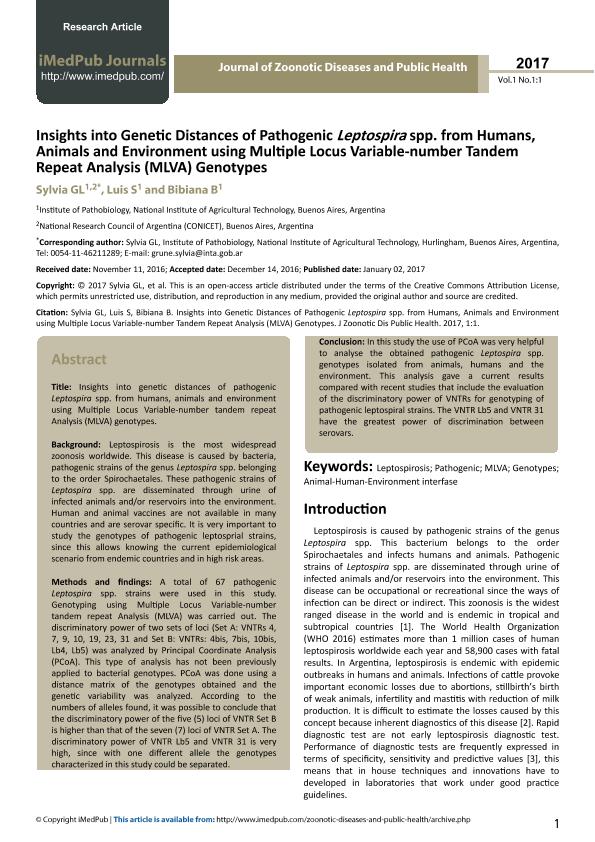Mostrar el registro sencillo del ítem
dc.contributor.author
Grune Loffler, Sylvia

dc.contributor.author
Samartino, Luis Ernesto

dc.contributor.author
Brihuega, Bibiana

dc.date.available
2019-06-18T19:27:39Z
dc.date.issued
2017-01
dc.identifier.citation
Grune Loffler, Sylvia; Samartino, Luis Ernesto; Brihuega, Bibiana; Insights into genetic distances of pathogenic Leptospira spp. from humans, animals and environment using Multiple Locus Variable-number tandem repeat Analysis (MLVA) genotypes; iMedPub; Journal of Zoonotic Diseases and Public Health; 1; 1; 1-2017; 1-8
dc.identifier.issn
0093-3821
dc.identifier.uri
http://hdl.handle.net/11336/78470
dc.description.abstract
Background: Leptospirosis is the most widespread zoonosis worldwide. This disease is caused by bacteria, pathogenic strains of the genus Leptospira spp. belonging to the order Spirochaetales. These pathogenic strains of Leptospira spp. are disseminated through urine of infected animals and/or reservoirs into the environment. Human and animal vaccines are not available in many countries and are serovar specific. It is very important to study the genotypes of pathogenic leptosprial strains, since this allows knowing the current epidemiological scenario from endemic countries and in high risk areas. Methods and findings: A total of 67 pathogenic Leptospira spp. strains were used in this study. Genotyping using Multiple Locus Variable-number tandem repeat Analysis (MLVA) was carried out. The discriminatory power of two sets of loci (Set A: VNTRs 4, 7, 9, 10, 19, 23, 31 and Set B: VNTRs: 4bis, 7bis, 10bis, Lb4, Lb5) was analyzed by Principal Coordinate Analysis (PCoA). This type of analysis has not been previously applied to bacterial genotypes. PCoA was done using a distance matrix of the genotypes obtained and the genetic variability was analyzed. According to the numbers of alleles found, it was possible to conclude that the discriminatory power of the five (5) loci of VNTR Set B is higher than that of the seven (7) loci of VNTR Set A. The discriminatory power of VNTR Lb5 and VNTR 31 is very high, since with one different allele the genotypes characterized in this study could be separated. Conclusion: In this study the use of PCoA was very helpful to analyse the obtained pathogenic Leptospira spp. genotypes isolated from animals, humans and the environment. This analysis gave a current results compared with recent studies that include the evaluation of the discriminatory power of VNTRs for genotyping of pathogenic leptospiral strains. The VNTR Lb5 and VNTR 31 have the greatest power of discrimination between serovars.
dc.format
application/pdf
dc.language.iso
eng
dc.publisher
iMedPub
dc.rights
info:eu-repo/semantics/openAccess
dc.rights.uri
https://creativecommons.org/licenses/by-nc-sa/2.5/ar/
dc.subject
Leptospirosis
dc.subject
Pathogenic
dc.subject
Mlva
dc.subject
Genotypes
dc.subject.classification
Otras Ciencias Veterinarias

dc.subject.classification
Ciencias Veterinarias

dc.subject.classification
CIENCIAS AGRÍCOLAS

dc.title
Insights into genetic distances of pathogenic Leptospira spp. from humans, animals and environment using Multiple Locus Variable-number tandem repeat Analysis (MLVA) genotypes
dc.type
info:eu-repo/semantics/article
dc.type
info:ar-repo/semantics/artículo
dc.type
info:eu-repo/semantics/publishedVersion
dc.date.updated
2019-06-06T15:58:50Z
dc.journal.volume
1
dc.journal.number
1
dc.journal.pagination
1-8
dc.journal.pais
India

dc.description.fil
Fil: Grune Loffler, Sylvia. Consejo Nacional de Investigaciones Científicas y Técnicas; Argentina. Instituto Nacional de Tecnología Agropecuaria. Centro de Investigación en Ciencias Veterinarias y Agronómicas. Instituto de Patobiología; Argentina
dc.description.fil
Fil: Samartino, Luis Ernesto. Instituto Nacional de Tecnología Agropecuaria. Centro de Investigación en Ciencias Veterinarias y Agronómicas. Instituto de Patobiología; Argentina
dc.description.fil
Fil: Brihuega, Bibiana. Instituto Nacional de Tecnología Agropecuaria. Centro de Investigación en Ciencias Veterinarias y Agronómicas. Instituto de Patobiología; Argentina
dc.journal.title
Journal of Zoonotic Diseases and Public Health
dc.relation.alternativeid
info:eu-repo/semantics/altIdentifier/url/http://www.imedpub.com/articles/insights-into-genetic-distances-of-pathogenic-leptospira-spp-from-humans-animals-and-environment-using-multiple-locus-variablenumb.php?aid=18087
dc.relation.alternativeid
info:eu-repo/semantics/altIdentifier/url/http://www.imedpub.com/articles/insights-into-genetic-distances-of-pathogenic-leptospira-spp-from-humans-animals-and-environment-using-multiple-locus-variablenumb.pdf
Archivos asociados
